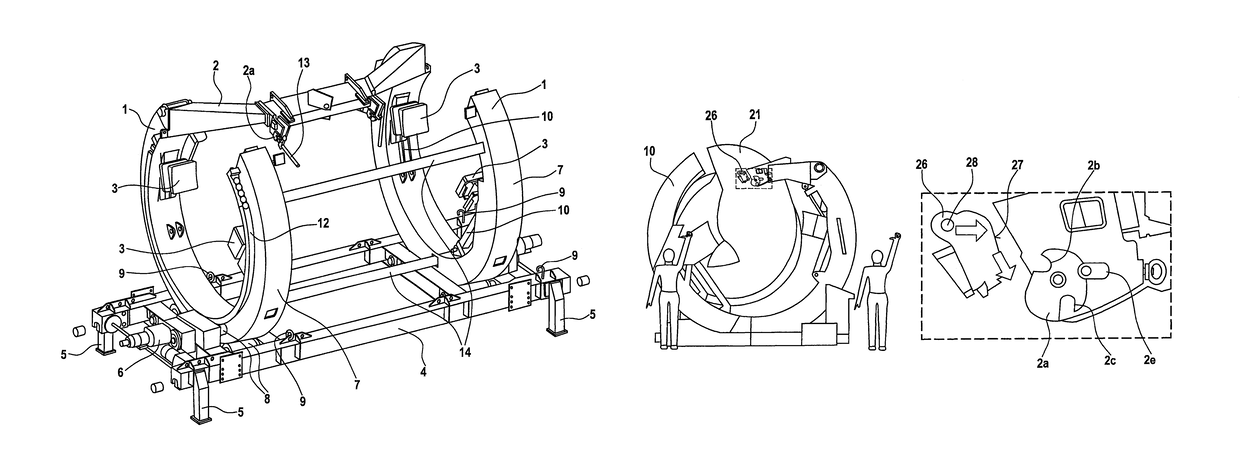Device for handling a wind turbine rotor blade
a technology for wind turbines and rotor blades, applied in the direction of machines/engines, sustainable buildings, final product manufacturing, etc., can solve the problems of rotor blades that have to be undamped, transported away and re-clamped, and have an adverse effect on the economy of rotor blades to be produced, so as to achieve better manufacturing
- Summary
- Abstract
- Description
- Claims
- Application Information
AI Technical Summary
Benefits of technology
Problems solved by technology
Method used
Image
Examples
first embodiment
[0035]FIG. 1 shows a perspective view of an apparatus for handling a wind power installation rotor blade according to a The apparatus has a main body 1 (for example in the form of a rotary ring) with two C-shaped elements connected together by way of transverse bars 14. A pivotal portion or a pivotal bar or yoke 2 can connect first ends of the C-shaped rotary rings together. The main body 1 is mounted on a main frame 4 rotatably for example by means of rolling bearings 8. Provided on the main body 1 are contact portions 3 which partially or optionally have auxiliary arms 10 mounted rotatably or pivotably to the main body 1. The contact portions 3 can be in the form of strap supports and are provided for bearing against a rotor blade which is let down or introduced into the main body 1. The main body 1 has first large rolling surfaces 7 and second small rolling surfaces 12. The first and second rolling surfaces 7 and 12 form a connection with the rolling bearings 8 arranged on the m...
second embodiment
[0053]FIG. 7 shows a cross-section through the FIG. 6 apparatus. The handling apparatus of the second embodiment has a main frame 4, a main body 1 mounted rotatably thereon for receiving the rotor blade, and a fixing device 30. The fixing device 30 has first and second portions 31, 32. The first portion 31 of the fixing unit 30 has a load or locking pin 33, rotatable wheels 35 and a spring 36 for example for prestressing the pin 33. The second portion 32 also has a pin 34 and a spring 37 for prestressing the pin. The rotor blade can be locked in the handling apparatus by those load pins 33, 34.
[0054]FIG. 8 shows a perspective view of the apparatus for handling a wind power installation rotor blade according to the second embodiment. The handling apparatus has a main frame 4 and a main body 1 mounted rotatably thereon. The main body 1 comprises for example two C-shaped and annular rotary rings having an opening, through which a rotor blade of a wind power installation can be introduc...
PUM
 Login to View More
Login to View More Abstract
Description
Claims
Application Information
 Login to View More
Login to View More - R&D
- Intellectual Property
- Life Sciences
- Materials
- Tech Scout
- Unparalleled Data Quality
- Higher Quality Content
- 60% Fewer Hallucinations
Browse by: Latest US Patents, China's latest patents, Technical Efficacy Thesaurus, Application Domain, Technology Topic, Popular Technical Reports.
© 2025 PatSnap. All rights reserved.Legal|Privacy policy|Modern Slavery Act Transparency Statement|Sitemap|About US| Contact US: help@patsnap.com



